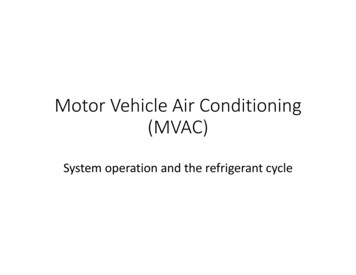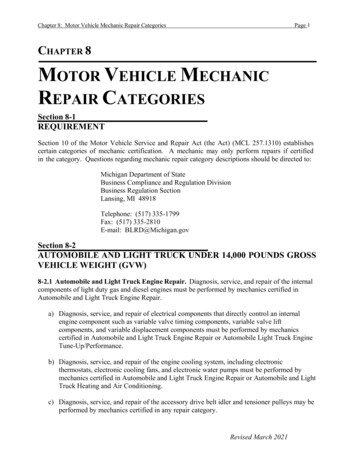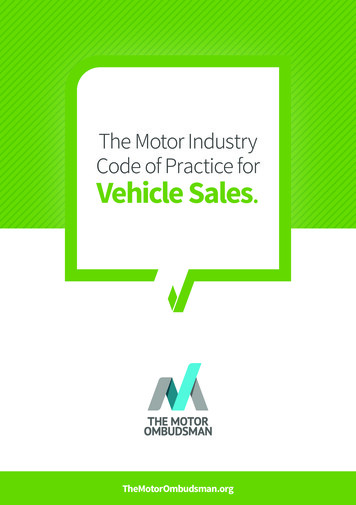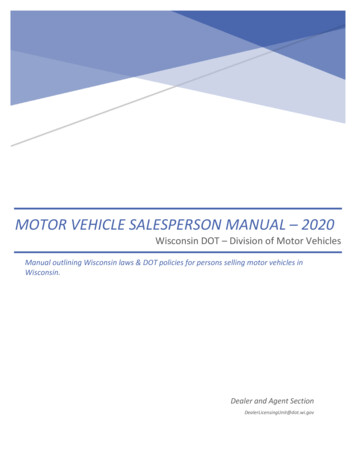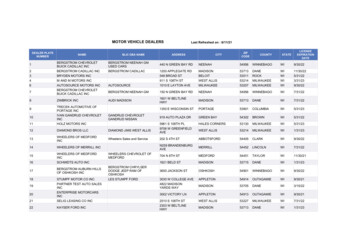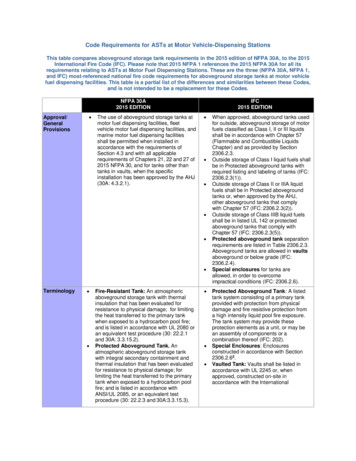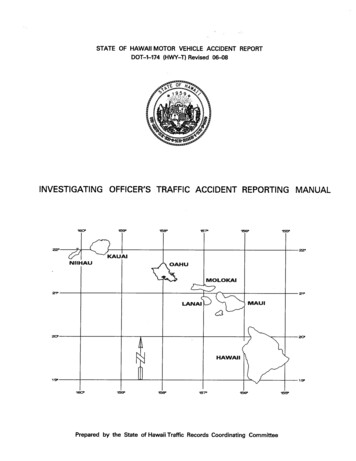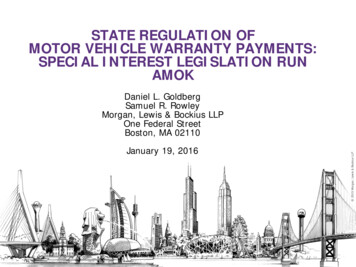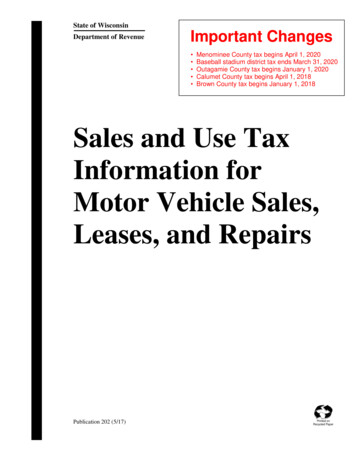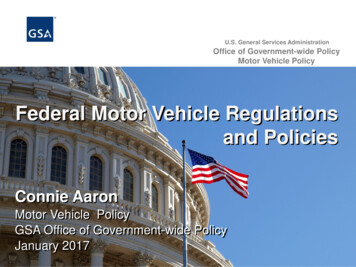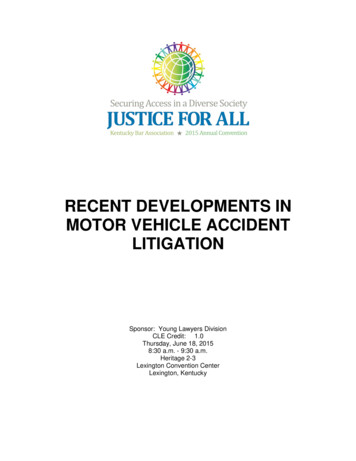
Transcription
RECENT DEVELOPMENTS INMOTOR VEHICLE ACCIDENTLITIGATIONSponsor: Young Lawyers DivisionCLE Credit: 1.0Thursday, June 18, 20158:30 a.m. - 9:30 a.m.Heritage 2-3Lexington Convention CenterLexington, Kentucky
A NOTE CONCERNING THE PROGRAM MATERIALSThe materials included in this Kentucky Bar Association Continuing LegalEducation handbook are intended to provide current and accurate information about thesubject matter covered. No representation or warranty is made concerning theapplication of the legal or other principles discussed by the instructors to any specificfact situation, nor is any prediction made concerning how any particular judge or jury willinterpret or apply such principles. The proper interpretation or application of theprinciples discussed is a matter for the considered judgment of the individual legalpractitioner. The faculty and staff of this Kentucky Bar Association CLE programdisclaim liability therefore. Attorneys using these materials, or information otherwiseconveyed during the program, in dealing with a specific legal matter have a duty toresearch original and current sources of authority.Printed by: Evolution Creative Solutions7107 Shona DriveCincinnati, Ohio 45237Kentucky Bar Association
TABLE OF CONTENTSThe Presenter . iRecent Developments in Motor Vehicle Accident Litigation . 1Introduction . 1Kentucky Supreme Court Decisions . 2Kentucky Court of Appeals Decisions . 9Kentucky Trial Court Cases . 22Federal Cases Involving Kentucky Law . 24
THE PRESENTERRhonda Jennings BlackburnGary C. Johnson, PSCPost Office Box 231Pikeville, Kentucky 41501-0231(606) 437-4002rblackburn@garycjohnson.comRHONDA JENNINGS BLACKBURN is an attorney with Gary C. Johnson, PSC inPikeville and practices in the area of personal injury. She received her B.A. fromMorehead State University and her J.D. from the University of Kentucky College of Law.Ms. Blackburn is a member of the Pike County, Kentucky, and West Virginia BarAssociations, American Association for Justice, Kentucky Justice Association, andPrimerus.i
ii
RECENT DEVELOPMENTS IN MOTOR VEHICLE ACCIDENT LITIGATIONRhonda BlackburnI.INTRODUCTIONThis session is intended to be a review of the trial and appellate court casesinvolving motor vehicles in Kentucky during calendar year 2014, and 2015 todate. Included are published and unpublished cases from the Kentucky SupremeCourt and Court of Appeals, a survey of Circuit Court trial verdicts, and casesinvolving Kentucky law from the federal Eastern and Western Districts ofKentucky.Kentucky's appellate courts issued a number of important rulings this past year.In Nichols v. Zurich American Insurance Co., 423 S.W.3d 698 (Ky. 2014), theSupreme Court held that an employer's concession that it was vicariously liableunder respondeat superior did not preclude a claim based on its ownindependent negligence: an employer's independent negligence in the hiring,training, retention, or supervision of an employee is conduct distinctly differentfrom, and independent of, the negligence of the employee whose conduct directlycaused the injury.The Court of Appeals designated "to be published" its holding that in determiningthe priority of coverage between two uninsured (UM) policies, the policy coveringthe injured person should be deemed primary to the policy covering the vehicle,rejecting the mutual repugnancy rule and apportionment in UM conflicts.Countryway Insurance Company v. United Financial Casualty Co., 2012-CA002051, 2014 WL 265508 (Ky. App. Jan. 24, 2014) – note the Supreme Courthas granted discretionary review.Other to-be-published holdings relevant to motor vehicle insurance include 1) an"owned but not scheduled for coverage" exclusion is unenforceable as againstpublic policy, in Tryon v. Encompass Indemnity Co., 2013-CA-001275, 2014 WL2536984 (Ky. App. Jun. 6, 2014); 2) UM coverage is applicable to every namedinsured listed on the policy with such coverage unless that named insured hasindividually signed a coverage waiver, in Boarman v. Grange IndemnityInsurance Co., 437 S.W.3d 748 (Ky. App. 2014); 3) the statute of limitations for aUIM claim accrues on the date the insurer denies coverage and communicatesthat to the insured, in Hensley v. State Farm Mutual Automobile Insurance Co.,2013-CA-000006 (Ky. App. Aug. 15, 2014); and 4) there is no requirement forexpert medical or scientific proof for emotional distress claims brought under theUnfair Claims Settlement Practices Act, in Indiana Insurance Co. v. Demetre,2013-CA-000338-MR, 2015 WL 393041 (Ky. App. Jan. 30, 2015) (propertyinsurance facts).Unpublished Court of Appeals cases dealt with a range of topics of interest to theMVA practitioner. Motorcycle UM/UIM coverage was at issue in two cases.Ballard v. State Farm Mutual Automobile Insurance Company, 2013-CA-001052,2015 WL 300638 (Ky. App. Jan. 23, 2015), where the Court of Appeals affirmeda summary judgment for the UM insurer in holding a helmet is not an integral part1
of a motorcycle, so the accident was not caused by a force projected by the hitand-run vehicle and this provision of policy was not triggered. In Black v.Nationwide General Insurance Co., 2013-CA-001439, 2014 WL 4377902 (Ky.App. Sep. 5, 2014) the UIM insurer's summary judgment was upheld on thegrounds that such coverage did not apply to a husband's non-covered motorcycleon which appellant was a passenger.Officers were held to have qualified official immunity in two suits arising frompolice pursuits. Plummer v. Lake, 2012-CA-001559, 2014 WL 1513294 (Ky. App.Apr. 18, 2014); and Jones v. Bennett, 2012-CA-001780, 2014 WL 3026440 (Ky.App. July 3, 2014).Immunity was also found for the Transportation Cabinet in its maintenance orinspection of "gore area" between highways and exit ramps. Kentucky v.Clayburn, 2012-CA-001680, 2014 WL 2154909 (Ky. App. May 23, 2014).Similarly, the decision not to place a guardrail and/or sign at the location where aone-car accident later occurred was also within the discretion of a county roadcrew. County of Boyd v. Quaffs, 2012-CA-001737, 2014 WL 2937784 (Ky. App.June 27, 2014).Other interesting holdings include the mere failure to terminate an employee isnot tantamount to ratification of that employee's prior misconduct for the purposeof punitive damages, in Big Spring Assembly of God, Inc. v. Stevenson, 2012CA-001350 & 2012-CA-001423, 2014 WL 4267433 (Ky. App. Aug. 29, 2014);and KRS 189.378 on funeral procession vehicles displaying flags or illuminatingheadlights does not impose a duty, statutory or common law, on a funeral home.Wallin v. Carriage Funeral Services of Kentucky, Inc., 2013-CA-000910, 2014WL 3548564 (Ky. App. July 18, 2014) and its companion case of Christian v.Steen Funeral Home, 2013-CA-001296, 2014 WL 4667326 (Ky. App. Sept. 19,2014).Finally, the U.S. District Court for the Western District of Kentucky ruled that KRS367.409(1), which forbids the solicitation of persons involved in MVAs (and theirrelatives) for thirty days after the accident for any service related to an MVA, isunconstitutional and unenforceable under federal law. State Farm Mut. Auto. Ins.Co. v. Conway, 3:13-CV-00229-CRS, 2014 WL 2618579 (W.D.Ky., June 12,2014).II.KENTUCKY SUPREME COURT DECISIONSA.To Be Published1.UIM coverage/mutual mistake.Nichols v. Zurich American Insurance Co., 2012-SC-000317-DG,423 S.W.3d 698 (Ky. 2014). This case arises out of a June 4,2002 collision between Nichols, a truck driver for Indiana-basedMiller Pipeline, and an automobile. The truck driver was seriouslyinjured, but the automobile driver had 25,000 in liability limits.Miller Pipeline had a commercial fleet policy issued by ZurichAmerican Insurance with an effective date of April 1, 2002, thatincluded a UIM endorsement with 1 million limits.2
In 2005, Nichols brought suit against Zurich in the JeffersonCircuit Court to recover his damages under the UIM coverageincluded in the Zurich policy. Zurich American obtained asummary judgment from that court, a judgment affirmed by theCourt of Appeals, on the grounds that the UIM coverage in thepolicy was actually the result of a mutual mistake in the making ofthe insurance contract – that is, Miller Pipeline had actuallyintended to reject UIM coverage in its fleet policy.The Supreme Court determined that reformation of the insurancecontract was improper. To reform a written contract upon theequitable grounds of mutual mistake, the proponent of thereformation must 1) show that the mistake was mutual, notunilateral; 2) the mutual mistake must be proven beyond areasonable controversy by clear and convincing evidence; and 3)it must be shown that the parties had actually agreed upon termsdifferent from those expressed in the written instrument. ZurichAmerican failed to establish the first element since "[t]here is noevidence that when it issued the policy on April 1, 2002, Zurichintended for the policy to exclude UIM coverage but mistakenlyissued a policy that included UIM coverage. The evidence is thatZurich intended to issue a policy with UIM coverage because ithad not been informed of Miller's desire to reject UIM coverageuntil after the accident occurred." This was simply a unilateralmistake by Miller Pipeline. The Supreme Court rejected theargument that the independent insurance broker's awareness ofMiller Pipeline's wishes regarding the policy should be imputed tothe insurer.Additionally, not until long after Nichols had settled his claim withthe tortfeasor for the 25,000 limits, did the Zurich officialnegotiating the claim with Nichols's counsel have knowledge thatZurich "knew" that Miller opted to reject UIM coverage and thatZurich had retroactively reformed the policy. An agreement maynot be reformed on the basis of mutual mistake when rights ofinnocent third parties will be prejudiced. The Supreme Courtconcluded that the doctrine of mutual mistake was erroneouslyapplied by the courts below; further, the lower courts'determination that Nichols was not entitled to summary judgmenton the issue of UIM coverage was also in error.Finally, while the trial court did not abuse its discretion in denyingNichol's motion to assert a statutory bad faith claim at the time, "i]tis appropriate that upon remand, the trial court shall re-evaluateNichols's motion to amend the complaint and consider, in light ofcurrent circumstances, what 'justice so requires' under CR 15.01."3
2.Respondeat superior/punitive damages.MV Transp., Inc. v. Allgeier, 433 S.W.3d 324 (Ky. 2014). MVoperates a paratransit bus service in Louisville. Their bus isequipped with a wheelchair lift. In December 2006, Allgeier (nowdeceased) was a sixty-five-year-old passenger who used awheelchair due to multiple sclerosis. In attempting to exit the bus,Allgeier could not see the bridge plate to the lift was not aligned:her wheelchair overturned, the driver released her safety belt, andshe fell onto the lowered lift, splintering each of her femurs.Instead of calling immediately for emergency medical assistance,the driver first contacted her dispatcher; the dispatcher thennotified MV supervisors, who arrived at the site about fifteen ortwenty minutes after the accident occurred. EMS only arrived afterAllgeier had been lying in intense pain on the freezing lift for fortyminutes.From the evidence presented at trial, a jury could reasonablyconclude the driver had substantially departed from the company'sunloading procedure. There was evidence the company'ssupervisors were lax in their training and enforcement of safetypolicies. Other evidence demonstrated that the driver was analcoholic living in a rehabilitation facility when hired by MV severalmonths before; the driver was tested for alcohol after the accident,but after the two-hour window in the company's protocol. (It wasnot alleged, and there was no evidence to indicate, that alcoholconsumption played any role in the accident.)In November 2007, Allgeier filed suit against MV, alleging that herinjury was caused by the driver's gross and ordinary negligencefor which MV was liable under the doctrine of respondeat superior.She also asserted that her injuries were caused by MV's owngross and ordinary negligence in the hiring, training, supervision,or retention of the driver.Before trial, the company was granted summary judgment onpunitive damages. The Jefferson Circuit jury found that MV wasvicariously liable under the doctrine of respondeat superior fortheir driver's negligence. The jury also found the company liablefor its own, independent negligence in hiring, training, supervising,or retaining its employee driver. Awarded 74,630.28 in medicalexpenses and 4.1 million in compensation for past, present, andfuture pain and suffering, Allgeier appealed the dismissal of herpunitive damage claim, and MV cross-appealed from the trialjudgment awarding compensatory damages, asserting evidence ofthe driver's alcoholism was improperly admitted.The Supreme Court first held that the alcoholism evidence,including the driver's deceptive responses on her employmentapplication, was properly admitted as impeachment evidence andthe company's broader objection to the evidence was notadequately preserved.4
Next, as a matter of first impression, the Supreme Court held thatMV's concession that it was vicariously liable under respondeatsuperior did not preclude a claim based on its own independentnegligence. The court rejected the "preemption rule" found insome jurisdictions. The rationale behind the preemption rule isthat allowing a claim based on an employer's direct negligence inhiring or supervising an employee to proceed concurrently withclaims based upon respondeat superior is redundant, undulyprejudicial to the employer, and could lead to duplicative damageawards.The court instead agreed with Allgeier's reasoning that anemployer's independent negligence in the hiring, training,retention, or supervision of an employee is conduct distinctlydifferent from, and independent of, the negligence of theemployee whose conduct directly caused the injury. Citing theSouth Carolina Supreme Court's analysis in James v. KellyTrucking Co., 661 S.E.2d 329 (S.C. 2008), our high court held the"fundamental flaw" of the preemption rule is that a stipulation as toone cause of action could somehow "prohibit" completely thepursuit of another:A plaintiff may, in a single lawsuit, assert manycauses of action against a defendant. Theconsiderations limiting a plaintiff's available causesof action in the typical case are that the plaintiffmust be able to demonstrate a prima facie case foreach cause of action and that a plaintiff mayultimately recover only once for an injury.Allgeier at 336, quoting James at 332. The court noted rejection ofthe preemption approach fits more consistently with Kentucky law,including our summary judgment standards, Civil Rule 8.01(1)("[r]elief in the alternative or of several different types may bedemanded") and Civil Rule 8.05(2) ("[a] party may also state asmany separate claims or defenses as he has regardless ofconsistency and whether based on legal or on equitable groundsor on both."). Accordingly, the Supreme Court held "that a plaintiffmay assert and pursue in the same action a claim against anemployer based under respondeat superior upon the agent'snegligence, and a separate claim based upon the employer's owndirect negligence in hiring, retention, supervision, or training. Theemployer's admission to the existence of an agency relationshipfrom which vicarious liability may arise does not supplant the claimthat the employer's own negligence, independent of thenegligence of the employee, may have caused or contributed tothe injury."The Supreme Court then addressed punitive damages, findingthat the trial court had erred in granting MV summary on thatclaim. The company argued first that the evidence at trial did not5
support punitives, and second, that the Court of Appeals erred byremanding the case for trial only on that claim, contending that atrial limited to the issue of punitive damages violates KRS411.186(1) and §7 of the Kentucky Constitution.Noting first that an employer may be liable for punitive damagesbased on the conduct of its employees, the Supreme Court heldsufficient evidence was presented at trial to establish the driver, inconjunction with the company's other employees, engaged inconduct that a reasonable jury could have found to be negligenceaccompanied by wanton or reckless disregard for Allgeier's lifeand safety. Further, a reasonable jury could properly concludefrom Allgeier's evidence, pursuant to KRS 411.184(3), that MVhad ratified, authorized, or should have anticipated its driver'sconduct.Next, the Supreme Court held a remand for retrial solely onpunitives is not prohibited by statute or the Kentucky Constitution.Such a retrial poses no risk of conflicting or overlapping verdicts.To argue that KRS 411.186(1), in providing that "[i]n any civilaction where claims for punitive damages are included, the jury orjudge if jury trial has been waived, shall determine concurrentlywith all other issues presented, whether punitive damages may beassessed" requires a retrial of all claims would lead to "an absurdand unreasonable result." Further, it would be "fundamentallyinequitable to require Allgeier to forfeit her compensatorydamages verdict as a precondition for obtaining what she shouldhave had in the first place – a jury's determination of whether sheis entitled to punitive damages." The Supreme Court thenremanded to the Jefferson Circuit Court for a trial on that issue.3.Directed verdict/presumption of negligence.Wright v. Carroll, 452 S.W.3d 127 (Ky. 2014). As appellant truckdriver entered a blind curve on a two-lane road, he encountered anumber of vehicles stopped in his lane waiting to turn left. Hebraked and steered right, towards the ditch to avoid rear-endingthem. Unfortunately his brakes locked and his trailer swung intothe opposing lane, striking appellee's vehicle and leading toserious injury.Appellee filed suit in Elliot Circuit Court against the trucker and thetrucking company, alleging negligent maintenance and operationof the tractor-trailer. In the first trial, the jury was instructed on thesudden-emergency doctrine and returned a defense verdict. Afterthe Court of Appeals held that the doctrine did not apply toencounters with vehicles properly stopped to turn at theintersection, the case was remanded. In the second trial, the jurywas not instructed on the sudden-emergency doctrine, but it wasalso not instructed on the trucker's duty to stay in the right lane,and returned another defense verdict. A second appeal resulted in6
the Court of Appeals holding the trial court should have grantedthe plaintiff's motion for directed verdict and issuing an order thatthe case be retried on damages only.On the Supreme Court's discretionary review, the trucker andtrucking company argued that the Court of Appeals erred byviolating the law-of-the-case doctrine, by applying an improperstandard of review and misstating material facts, andmisconstruing KRS 189.300(1) on keeping to the right.The general principle of the law-of-the-case is that a courtaddressing later phases of a lawsuit should not reopen questionsdecided by that court or by a higher court during earlier phases ofthe litigation. In Carroll I, the Court of Appeals held that it wasimproper for the jury to be instructed on the sudden emergencydoctrine. However, the court added, "[o]n th
Countryway Insurance Company v. United Financial Casualty Co., 2012-CA-002051, 2014 WL 265508 (Ky. App. Jan 24, 2014) . note the Supreme Court – has granted discretionary review. Other to-be-published holdings relevant to motor vehicle insurance include ) an 1 "owned but not scheduled for coverage exclusion is unenforceable as against "


